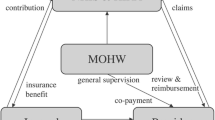Abstract
Background
The appropriate structure, scope and cost of government incentives in the private health insurance (PHI) market is a matter of ongoing debate.
Objective
In order to inform policy decisions we designed a two-stage study to (1) model the uptake of PHI covering hospital treatment in Australia, and (2) identify the costs of various policy scenarios to the government.
Methods
Using a microsimulation with a cost-benefit component, we modelled the insurance decisions made by individuals who collectively represented the Australian insurance population in the financial year 2014–15.
Results
We found that the mean willingness to pay (WTP) for PHI ranged from A$446 to A$1237 per year depending on age and income. Our policy scenarios showed a considerable range of impacts on the government budget (from A$4 billion savings to A$6 billion expense) and PHI uptake (from 3.4 million fewer to 2.5 million more individuals insured), with cost-effectiveness ranging from −A$305 to A$22,624 per additional person insured, relative to the status quo.
Conclusions
Based on the scenario results we recommend policy adjustments that either increase the PHI uptake at a small per-person cost to the public budget or substantially reduce government subsidisation of PHI at a relatively small loss in terms of persons insured.

Similar content being viewed by others
References
Private Health Insurance Administration Council. Quarterly statistics June 2014. Sydney: Private Health Insurance Administration Council; 2014.
Mossialos E, Wenzl M, Osborn R, Anderson C. International profiles of health care systems. New York: The Commonwealth Fund; 2015.
Australian Institute of Health and Welfare. Expenditure data. www.aihw.gov.au/expenditure-data/. Accessed 6 June 2015.
Frech HE, Hopkins S, MacDonald G. The Australian private health insurance boom: was it subsidies or liberalised regulation? Econ Pap J Appl Econ Policy. 2003;22:58–64.
Frech HE, Hopkins S. Why subsidise private health insurance? Aust Econ Rev. 2004;37:243–56.
Ellis RP, Savage E. Run for cover now or later? The impact of premiums, threats and deadlines on private health insurance in Australia. Int J Health Care Finance Econ. 2008;8:257–77.
Segal L. Why it is time to review the role of private health insurance in Australia. Aust Health Rev. 2004;27:3–15.
Denniss R. Who benefits from private health insurance in Australia? New Dr. 2005;83:23–4.
Walker A, Percival R, Thurecht L, Pearse J. Distributional impact of recent changes in private health insurance policies. Aust Health Rev. 2005;29:167–77.
Seah DSE, Cheong TZ, Anstey MHR. The hidden cost of private health insurance in Australia. Aust Health Rev. 2013;37:1–3.
Hajizadeh M, Connelly LB, Butler JRG. Health policy and equity of health care financing in Australia: 1973–2010. Rev Income Wealth. 2014;60:298–322.
Hopkins S, Zweifel P. The Australian health policy changes of 1999 and 2000. Appl Health Econ Health Policy. 2005;4:229–38.
Australian Government Department of Human Services. Portfolio budget statements 2016–17. Budget Related Paper No. 1.15B. Commonwealth of Australia, Canberra ACT; 2016.
Breidert C, Hahsler M, Reutterer T. A review of methods for measuring willingness-to-pay. Innov Market. 2006;2(4):8–32.
Brandimarte P. Handbook in Monte Carlo simulation: applications in financial engineering, risk management, and economics. Hoboken: Wiley; 2014.
Australian Bureau of Statistics. AHS sample design and selection. Australian health survey: users’ guide, 2011–13. Canberra: Commonwealth of Australia; 2013.
Australian Bureau of Statistics. Australian demographic statistics. Canberra: Commonwealth of Australia; 2015.
Online quotes for persons born in Jan 1970 in various family configurations. http://comparethemarket.com.au. Accessed 25 Aug 2015.
Australian Bureau of Statistics. Census of population and housing. Canberra: Commonwealth of Australia; 2011.
Australian Bureau of Statistics. Wage price index, Australia, June 2015. Canberra: Commonwealth of Australia; 2015.
Kohli R, Mahajan V. A reservation-price model for optimal pricing of multiattribute products in conjoint analysis. J Market Res. 1991;28(3):347–54.
Robson A, Paolucci F. Private health insurance incentives in Australia: the effects of recent changes to price carrots and income sticks. Geneva Pap. 2012;37:725–44.
Bock JO, Heider D, Matschinger H, Brenner H, Saum KU, Haefeli WE, Koenig HH. Willingness to pay for health insurance among the elderly population in Germany. Eur J Health Econ. 2016;17(2):149–58.
Private Healthcare Australia. Private health insurance premium prices in Australia. http://privatehealthcareaustralia.org.au. Accessed 07 Aug 2015.
Department of Health and Ageing and enHealth Council. Guidelines for economic evaluation of environmental health planning and assessment, vol. 1. The guidelines. Canberra: Commonwealth of Australia; 2003.
Australian Government Treasury. Intergenerational report: Australia in 2055. Canberra: Commonwealth of Australia; 2015.
Doiron D, Jones G, Savage E. Healthy, wealthy and insured? The role of self-assessed health in the demand for private health insurance. Health Econ. 2008;17:317–34.
Buchmueller TC, Fiebig DG, Jones G, Savage E. Preference heterogeneity and selection in private health insurance: the case of Australia. J Health Econ. 2013;32:757–67.
Australia Ipsos. Healthcare and insurance survey. Sydney: Ipsos Healthcare; 2009.
Butler JRG. Policy change and private health insurance: did the cheapest policy do the trick? Aust Health Rev. 2002;25(6):33–41.
Cheng TC. Measuring the effects of reducing subsidies for private insurance on public expenditure for health care. J Health Econ. 2014;33:159–79.
Australian Government Department of Health. Lifetime health cover. www.health.gov.au/internet/main/publishing.nsf/content/health-privatehealth-lhc-providers-general.htm. Accessed 20 July 2015.
Australian Government Department of Health. Private health insurance circular PHI 27/14. Canberra: Commonwealth of Australia; 2014.
Author information
Authors and Affiliations
Contributions
All authors contributed to the study concept and definition of policy scenarios. PMS and SK designed the microsimulation and analysed the data. PMS, JB and PAS wrote the manuscript.
Corresponding author
Ethics declarations
This study is an independent academic work following from a prior consultancy report prepared for Private Healthcare Australia (PHA), the peak body representing private health insurers in Australia. The researchers received financial and material support from PHA in the preparation of the consultancy report. The methods and results in this paper have been modified substantially since that report. PMS, SK, JB, SKN, TC and PAS declare no conflicts of interest.
Rights and permissions
About this article
Cite this article
Sowa, P.M., Kault, S., Byrnes, J. et al. Private Health Insurance Incentives in Australia: In Search of Cost-Effective Adjustments. Appl Health Econ Health Policy 16, 31–41 (2018). https://doi.org/10.1007/s40258-017-0338-6
Published:
Issue Date:
DOI: https://doi.org/10.1007/s40258-017-0338-6




